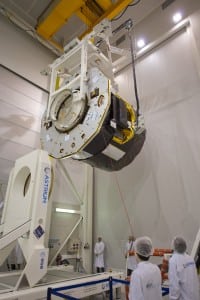Astrium-built Space Telescope in Transit for Launch

Gaia flight model during X-axis CoG (Centre of Gravity) and inertia measurements at Intespace, Toulouse, France, 15 March 2013.
Image credit: ESA–S. Corvaja, 2013
[Via Satellite 08-23-13] Gaia, believed to be the most advanced space telescope built in Europe, has left the Toulouse facilities of Astrium after final integration and testing. The spacecraft is now in transit to its launch site in French Guiana, where it will be prepared for launch aboard Soyuz.
Designed and built by Astrium for the European Space Agency (ESA), Gaia is purposed to produce the most detailed map of our galaxy, the Milky Way, and reveal as yet unknown zones. Its goal is to aid in the understanding of the origins and evolution of the universe. The mission is also expected to discover hundreds of thousands of unidentified celestial objects, including extra-solar planets and failed stars, known as brown dwarfs. Within our Solar System, Gaia will be able to identify tens of thousands of additional asteroids.
Like the instruments made by Astrium for Earth observation missions, Gaia’s space telescope is the result of expertise developed by Astrium in the field of silicon carbide (SiC) telescopes with its partner Boostec. Gaia will also use a photographic sensor of record accuracy. From the moon, it would be able to measure the thumbnail of a person standing on Earth. It has a huge focal plane made up of 106 CCD detectors gathering 1 billion pixels. For its attitude control, the spacecraft will also use cold gas propulsion (nitrogen), which will allow it to continuously adjust pointing performance with the required extreme accuracy.
Gaia will be located at one of the five Lagrangian points in the Sun-Earth system, at the L2 point. Lagrangian points are very precise points in the cosmos where a satellite remains fixed and perfectly stable in space. Located 1.5 million kilometers from Earth, these locations are important for astronomy observation missions which require high pointing stability.